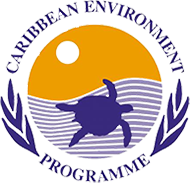Collaboration under the United Nations Development Programme/Global Environment Facility (UNDP/GEF) Caribbean Large Marine Ecosystem (CLME+) Project
The Cartagena Convention Secretariat through its two technical Sub-Programmes on marine biodiversity (SPAW) and pollution (AMEP/LBS) in collaboration with The Ocean Foundation (TOF), is developing the “CLME+ baseline and (pre) feasibility assessment and investment plan for large-scale action on habitat protection and pollution prevention” under the UNDP GEF CLME+ Project. This activity aims to join efforts on the international agenda, such as, the Decade of Restoration (2021 -2030)[1], which calls for the restoration of degraded and destroyed ecosystems to combat the climate crisis and improve food security, water supply, and biodiversity; the Sustainable Development Goals (SDGs)[2], specially SGDs 6, 13, 14, 15; the Strategic Plan for Biodiversity 2011-2020 and the Aichi Biodiversity Targets[3].
Within the Convention, the Sub-Programmes are mutually supportive and the implementation of one contributes to the achievement of the other. The results of this feasibility assessment and investment plan therefore support the objectives of the SPAW and LBS Protocols which focus on the need for habitat restoration and pollution prevention, respectively.
As one of the most biologically rich marine environments in the Atlantic, the Wider Caribbean Region (WCR) is highly dependent on its marine and coastal resources. The growing impacts of unsustainable coastal development, climate change, overfishing, and marine pollution threaten the viability of the region's marine and coastal ecosystems. Hence, protecting marine ecosystems in the Caribbean is vital to safeguarding the future of countries and territories in the region. Moreover, restoring these ecosystems increases the supply and quality of ecosystem services over time towards desired outcomes that support national sustainable development.
A key aspect of this project component is the development of a large-scale habitat restoration site prioritization methodology. This is critical for regional decision-makers and resource managers to determine how to allocate limited resources and develop clear environmental, economic, and social goals for restoration projects. For the methodology, TOF identified three “Indicators of Need” and five “Indicators for Feasibility” that have existing, widely accepted data. Additional “Need” indicators were selected partly because of the availability of mapping tool data. Additional “Feasibility” indicators were selected due to their relevance in commitments to Global and Regional Programs (see the “Regional Strategy and Action Plan (RSAP) for the Valuation, Protection and/or Restoration of Key Marine Habitats in the Wider Caribbean Report,” under the SPAW Sub-Programme which lists four main goals of restoration and how those goals fit into the objectives of Regional and Global Programmes/Strategies).
Using these indicators, a 4-part scorecard was developed which starts at the country-level and narrows its focus down to specific large-scale habitat restoration sites. Through this process, a total of 19 scorecards for 16 countries was produced in the WCR region. A total of 48 unique large-scale habitat restoration sites were identified through this process.
This list of high-priority sites guides TOF’s focus as they work to develop replicable models for investment plans that utilize a blended finance approach to habitat restoration, and conservation and pollution prevention. By mapping beneficiaries, including private, social, and public, they can link blended finance, economic valuation of ecosystem services and broader socio-economic and cultural benefits. This allows integration of public, private, and philanthropic capital, not only to support the design and implementation of restoration projects, but also the long-term monitoring needed to measure success.
As a regional community, we all recognize the urgency of addressing climate change while promoting sustainable economic development. With this methodology, the collaborative effort will help pave the way for strategic action expected to help the WCR rally private investors, non-profit organizations, and government actors to restore and protect coastal ecosystems, as well as reduce pollution stressors that increase our climate resilience – this will enable the promotion of sustainable blue economy approaches.






